 Java
Java
 javaTutorial
javaTutorial
 How to quickly implement Spring security permission authentication management (detailed steps)
How to quickly implement Spring security permission authentication management (detailed steps)
How to quickly implement Spring security permission authentication management (detailed steps)
The content of this article is about how to quickly implement Spring security permission authentication management (detailed steps). It has certain reference value. Friends in need can refer to it. I hope it will be helpful to you.
1. Build the project
Let’s get started without further ado.
pom.xml:
The core dependencies of spring security are as follows
<!-- spring security --> <dependency> <groupid>org.springframework.boot</groupid> <artifactid>spring-boot-starter-security</artifactid> </dependency> <!-- spring security data --> <dependency> <groupid>org.springframework.security</groupid> <artifactid>spring-security-data</artifactid> </dependency>
Configure the user main class: User and implement security’s UserDetails
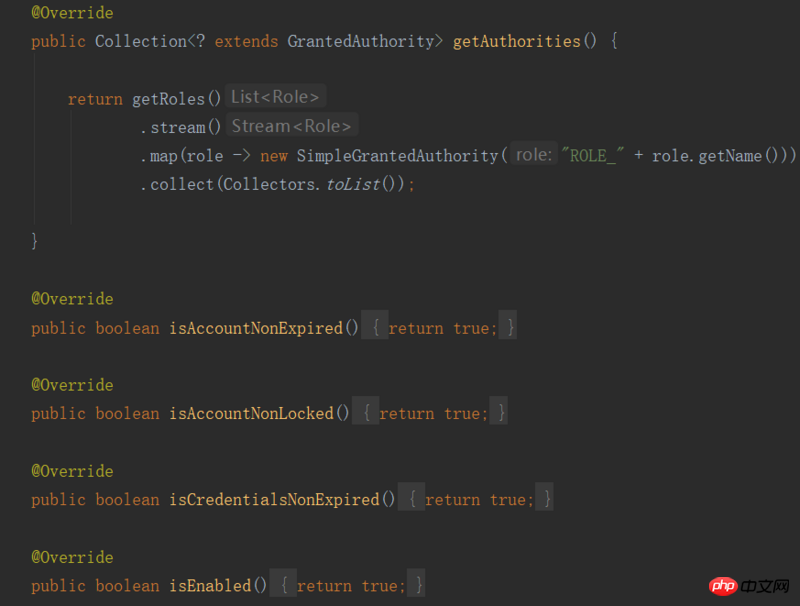
Override several of its methods. The default configuration is false and needs to be changed to true. 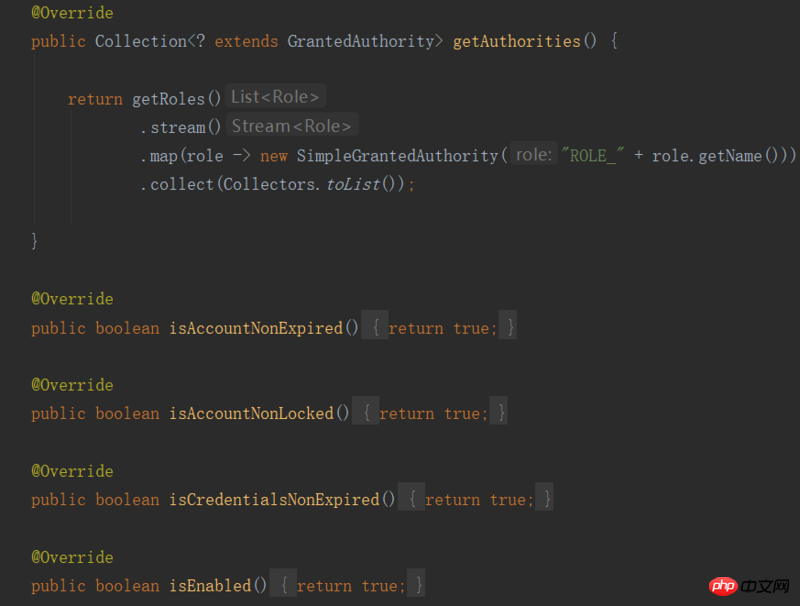
#Configure UserService to implement the UserDetailsService interface and override the loadUserByUsername method.
This method is used during security login. The queried information must include user information and role information.
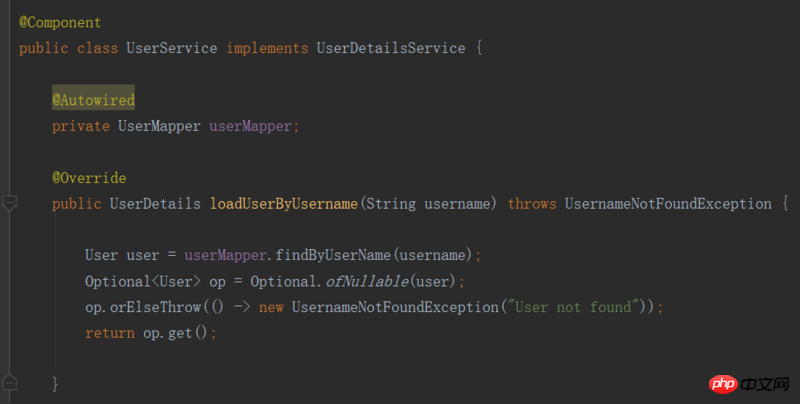
2. Test
Create UserController, since we configured .antMatchers("/login","/register above ") allows access to only these two interfaces when not logged in.
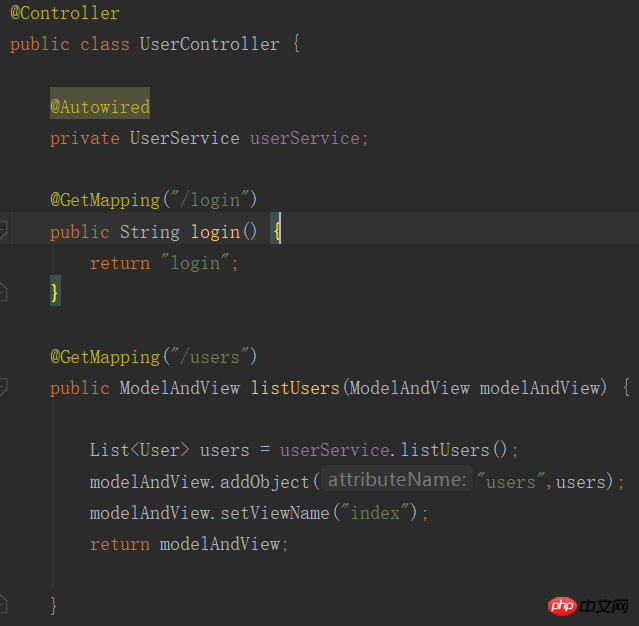
When you are not logged in, accessing non-permitted interfaces will redirect you to login.
The effect is as follows:
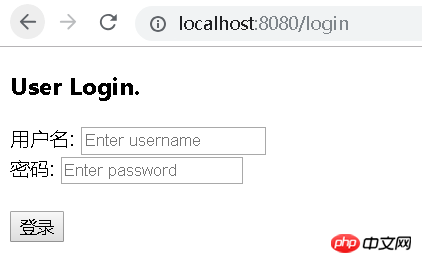
After successful login, access /users

We have easily implemented login authorization, so that our API is protected.
If you need to specify the access permissions for different roles, just add an annotation to the Controller.
@PreAuthorize("hasRole('ROLE_ADMIN')")//Requires administrator identity
@PreAuthorize("hasRole('ROLE_USER')")//Requires user identity
3. Ending
Through the above brief description, we have completed the integration of Spring boot mybatis with Spring security.
Due to limited time, I will only give a brief description in the article. Visit my Github to view the complete Demo.
url: https://github.com/admin79/SecurityDemo
The above is the detailed content of How to quickly implement Spring security permission authentication management (detailed steps). For more information, please follow other related articles on the PHP Chinese website!

Hot AI Tools

Undresser.AI Undress
AI-powered app for creating realistic nude photos

AI Clothes Remover
Online AI tool for removing clothes from photos.

Undress AI Tool
Undress images for free

Clothoff.io
AI clothes remover

AI Hentai Generator
Generate AI Hentai for free.

Hot Article

Hot Tools

Notepad++7.3.1
Easy-to-use and free code editor

SublimeText3 Chinese version
Chinese version, very easy to use

Zend Studio 13.0.1
Powerful PHP integrated development environment

Dreamweaver CS6
Visual web development tools

SublimeText3 Mac version
God-level code editing software (SublimeText3)

Hot Topics
 1377
1377
 52
52
 Perfect Number in Java
Aug 30, 2024 pm 04:28 PM
Perfect Number in Java
Aug 30, 2024 pm 04:28 PM
Guide to Perfect Number in Java. Here we discuss the Definition, How to check Perfect number in Java?, examples with code implementation.
 Random Number Generator in Java
Aug 30, 2024 pm 04:27 PM
Random Number Generator in Java
Aug 30, 2024 pm 04:27 PM
Guide to Random Number Generator in Java. Here we discuss Functions in Java with examples and two different Generators with ther examples.
 Weka in Java
Aug 30, 2024 pm 04:28 PM
Weka in Java
Aug 30, 2024 pm 04:28 PM
Guide to Weka in Java. Here we discuss the Introduction, how to use weka java, the type of platform, and advantages with examples.
 Smith Number in Java
Aug 30, 2024 pm 04:28 PM
Smith Number in Java
Aug 30, 2024 pm 04:28 PM
Guide to Smith Number in Java. Here we discuss the Definition, How to check smith number in Java? example with code implementation.
 Java Spring Interview Questions
Aug 30, 2024 pm 04:29 PM
Java Spring Interview Questions
Aug 30, 2024 pm 04:29 PM
In this article, we have kept the most asked Java Spring Interview Questions with their detailed answers. So that you can crack the interview.
 Break or return from Java 8 stream forEach?
Feb 07, 2025 pm 12:09 PM
Break or return from Java 8 stream forEach?
Feb 07, 2025 pm 12:09 PM
Java 8 introduces the Stream API, providing a powerful and expressive way to process data collections. However, a common question when using Stream is: How to break or return from a forEach operation? Traditional loops allow for early interruption or return, but Stream's forEach method does not directly support this method. This article will explain the reasons and explore alternative methods for implementing premature termination in Stream processing systems. Further reading: Java Stream API improvements Understand Stream forEach The forEach method is a terminal operation that performs one operation on each element in the Stream. Its design intention is
 TimeStamp to Date in Java
Aug 30, 2024 pm 04:28 PM
TimeStamp to Date in Java
Aug 30, 2024 pm 04:28 PM
Guide to TimeStamp to Date in Java. Here we also discuss the introduction and how to convert timestamp to date in java along with examples.
 Create the Future: Java Programming for Absolute Beginners
Oct 13, 2024 pm 01:32 PM
Create the Future: Java Programming for Absolute Beginners
Oct 13, 2024 pm 01:32 PM
Java is a popular programming language that can be learned by both beginners and experienced developers. This tutorial starts with basic concepts and progresses through advanced topics. After installing the Java Development Kit, you can practice programming by creating a simple "Hello, World!" program. After you understand the code, use the command prompt to compile and run the program, and "Hello, World!" will be output on the console. Learning Java starts your programming journey, and as your mastery deepens, you can create more complex applications.



